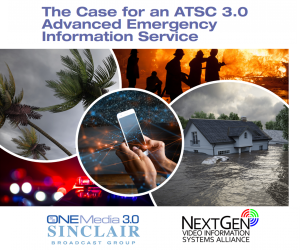 Josh Gordon is the President of Josh Gordon Group and the research project manager of the study, “The Case for an ATSC 3.0 Advanced Emergency Information Service.”
Josh Gordon is the President of Josh Gordon Group and the research project manager of the study, “The Case for an ATSC 3.0 Advanced Emergency Information Service.”A new research study from NVISA (NextGen Video Information Systems Alliance) sponsored by ONE Media 3.0/Sinclair Broadcast Group makes some significant findings surrounding Emergency Broadcast services and NextGen Broadcasting.
Over 2,000 American consumers were asked about the emergency information resources they currently use during local emergencies and which advanced features they would like to see. The findings were noteworthy:
- Almost two-thirds of American consumers want “the ability to receive geo-targeted alerts.”
- Over half chose “the ability to select only the alerts they want to receive.”
- Over half of Americans also chose “the ability to opt into a constantly updated stream of emergency information.”
- Almost half of consumers want “a system that keeps working when their Internet goes down.”
- More than a third want “a system that keeps working when their cellular phone service goes down.”
Significantly, the costs of such targeted services were not seen as a deterrent. When asked how much more they would be willing to pay for their next mobile phone purchase so it could do an outstanding job delivering critical information in an emergency, almost two thirds of American consumers said they would pay an extra $5, and almost half said they would pay an extra $10.
Because emergency alerts and information are shared with consumers differently than they were ten years ago the study asked American consumers which emergency information resources they are now using. Again, the findings were illuminating:
- American consumers can choose from a vast number of emergency resources that are very fragmented.
- Despite the number of options, two thirds of all Americans make their “first stop” either their mobile phone or TV news. Often this “first stop” is not an emergency information source but a destination that helps them either begin their search more effectively or confirm the seriousness of a threat.
- After their “first stop,” American consumers search for emergency information sources. The top two destinations are local emergency government sources, which includes city/town, state, and regional emergency management, and local TV news stations.
- Overall, the three most frequently used resources by far are mobile phones, local government emergency information sources, and local TV news. These do not compete, they complement each other.
The full study entitled, “The Case for an ATSC 3.0 Advanced Emergency Information Service” can be found on either of the following websites:
NVISA – https://www.nvisa.org/documents
ONE Media 3.0 – https://www.atsc3advocate.com/downloads


